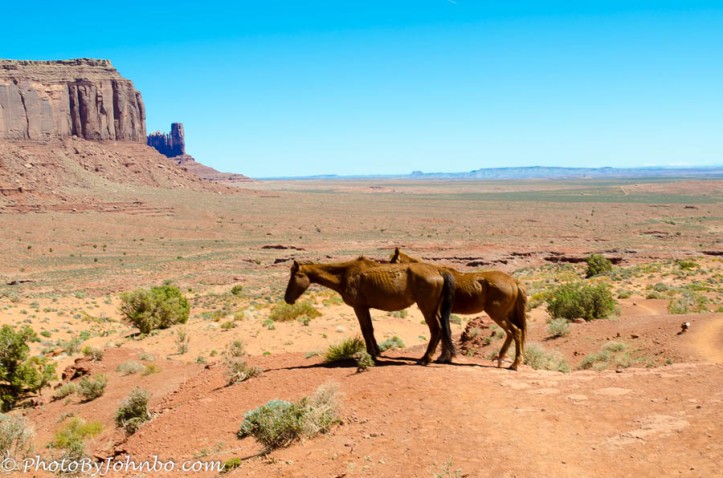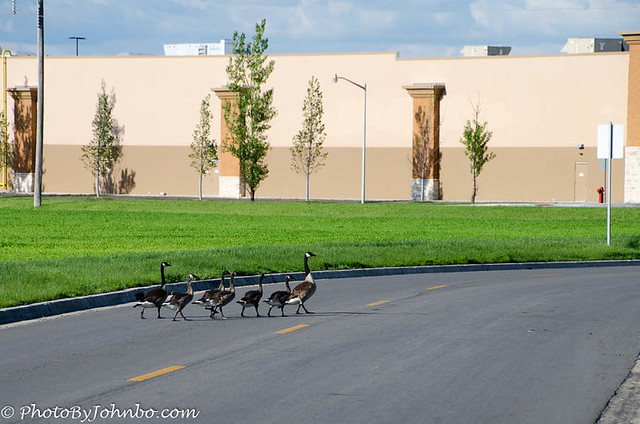
This week, it’s Tina’s turn to host the challenge, and she’s asked us to focus on habitats, human and animal. She writes, “We are the stewards of this beautiful planet, still learning how to protect and share its resources. We hope you’ll join us this week to explore the habitats of both human and/or animal ‘residents.'” You can read her entire challenge post here.
When I searched for wildlife photos to populate my response, I was surprised that I had many more images than I thought. Life in the desert is hard in Arizona and Utah’s vast Monument Valley area. There are several herds of wild mustangs there. As we hiked the desert trail around the Mittens rock formations, we saw a pair of horses who looked like they could use a good meal.
In the summer, mountain goats stay above the tree line, where they can find plenty of food. In the winter, they migrate to lower elevations, where they can find food and shelter from the harshest weather.
Pronghorn are found in open prairie and desert habitats across western North America. Though often called antelope, their closest living relatives are giraffes and okapis. Some of the highest pronghorn populations can be found in Wyoming’s Red Desert and Yellowstone ecosystems.
Crocodiles live in freshwater habitats worldwide, including lakes, rivers, swamps, and wetlands. Some species, such as the American crocodile, can tolerate brackish water, a mixture of salt and freshwater. A few species live in a saltwater environment. The Everglades are a mixture of fresh and brackish water with more freshwater in the inland regions.
California sea lions are found along the eastern North Pacific Ocean’s coast, from southeast Alaska to central Mexico. Their primary breeding range is off the coast of California and Mexico. This large male enjoyed the day at home on the rocks near La Jolla.
According to Google, anhingas are found in warm and temperate regions in the Americas, Africa, and Asia. They are great fishers and prefer shallow, slow-moving freshwater habitats with nearby trees or other perches for drying and sunning. This specimen was photographed in the Florida Everglades.
There are two varieties of shearwater birds in Hawaii. They nest at low-elevation sites on almost every island in the Hawaiian chain, including burrows under sand, soil, tree roots, or loose rocks. This chick awaited its mother’s return with food at the Kilauea Point National Wildlife Refuge on Kauai.
Some geese families live near a pond in Moorhead, Minnesota. This family braves traffic on an Interstate frontage road as it transits between the pond and a large area with plenty of food.
This collection of residents was likely inhabited by the Sinagua people. They are believed to have been the primary builders and inhabitants of Montezuma Castle, living there from approximately 1100 to 1425 AD. The name Montezuma Castle is really a misnomer. Montezuma and his contemporaries never lived in southern Arizona.
The Sinagua at Montezuma’s Castle might be considered living in a “small town.” According to Google, the inhabitants of Mesa Verde in Colorado were the Ancestral Puebloans. Their large apartment-style dwellings at Mesa Verde are more like a big city. Mesa Verde is famous for its cliff dwellings and multi-story stone structures built into the sides of cliffs. However, the Ancestral Puebloans also lived in above-ground villages and pit houses. They likely chose the cliff dwellings for defense, access to sunlight, and cultural significance.
The world combines rural areas, small towns, and big cities. This long-term resident of the United States is familiar with these lifestyles only in this country. I have seen a few examples of European environments, but only as a tourist. I could have included many images of life in Fargo, but instead, I decided to feature an image from Hillsborough, North Carolina. Indeed, according to the 2020 Census, the small town’s population was less than 10,000 residents.
Millions of people prefer to live in large cities, one of the largest of which is New York City. Manhattan Island contains most of the Borough of Manhattan, with approximately 1.6 million residents as of the 2020 census. Comparing the areas of Manhattan Island, at 22.6 square miles (58.7 sq km), to Hillsborough, at 4.6 square miles (12 sq km), Manhattan Island is about five times larger in area but contains about 160 times the population.
Thanks to Tina for this week’s challenge. I discovered how many wildlife photos I have in my galleries. I can now consider myself a wildlife photographer… well, I like to think that, anyway.
Last week, Egidio brought us the Two Rectangles Challenge, a concept I discovered that I use even though I didn’t know it. One of the advantages of participating in these challenges is learning about photographic concepts that are new to us.
The Lens-Artists Team will be on a summer hiatus starting next week. There will be no challenge the first week of July. We welcome guest hosts for the remaining weeks in July. Here’s the schedule that Tina posted on her challenge this week.
July 13: Leanne of Leanne Cole explores TOURIST ATTRACTIONS
July 20: Elizabeth of Albatz Travel Adventures leads us with PAIRS
July 27: PR of Flights of the Soul presents BALCONIES
John Steiner












These are great choices, the first thought was after the first image was western movie 🙂 These other animal images showed beautifully the habitat which was not all that obvious in my photos. Mese Verde was also interesting.
Thanks, Ritva! I admit to having to search a bit for most of the photos. >grin<
Lovely examples for the theme!
Geese my favourite
Geese seem to get along in an urban environment quite nicely, and they will defend their right to be there if confronted by humans. >grin<
John, great post! I love the way you featured many different animal and human habitats. I enjoyed all of the images.
Thanks! Fun challenge.
I enjoyed this post very much. I loved the animal photos and descriptions you had. It was also very nice how you progressed from wildlife to humans, including the beautiful Ancestral Puebloan people’s cliff dwellings. Beautiful photos.
Thanks, Egidio! I struggled a bit with human habitation images until I thought of the ruins.
Excellent examples John.
Thanks, VJ!
Welcome
Thanks for the tour, history and wonderful images John.
It’s been fun reading everyone’s responses for this topic.
😊
Lovely photo John, love the variety and bird ones especially
Thanks, Brian! I need to do more bird photography, and I’ve finally got some equipment to make that more likely to happen. Stay tuned! 🙂
Excellent
Great examples!
Thanks!
I enjoyed seeing the wildlife of your desert and mountain regions in particular. And what an interesting comparison of population density between Hillsborough and Manhattan!
Thanks, Sarah! Having lived in big cities and small, I prefer small, but always enjoy sojourns to the big cities of the country.
This is such a great post. I’m astonished at the range of habitats and their inhabitants that you’ve captured. Take a bow!
Thanks for the nice compliment, Margaret!
Well done John! You covered the gamut on this one 😊. I loved the rock-dwelling images – something I’ve not seen but would love to.
Back in earlier days of these parks, people were allowed to visit the ruins, but as you might guess, they have been closed for interior views. A very few have ranger guided tours.
Your wildlife photos are wonderful, John! Yes, you are a wildlife photographer 🙂 I am fascinated by the cliff dwellings. Such ingenuity.
Thanks, Marie!
You answered the challenge beautifully, John. I’ve been wanting to go back to Montezuma Castle, so I enjoyed seeing your photo of it.
Thanks, Janet. I would like to visit again as well. It is an easy stop off I-17.
It is.
I very much enjoyed your take on, John. And great that you featured the old human dwellings. I love visiting such places, but read in your comments that these ones now are closed.
Thanks, Ann-Christine. Unfortunately in most cases. They are. Some sites now offer ranger-led tours. I am not sure about Mesa Verde.